
|
Fallow Deer The ecology of the European Fallow Deer (Dama dama dama) INTRODUCTION There is only one species of Fallow Deer (Dama dama) which is broken down into two distinct sub-species; the European Fallow ( Dama dama dama) and the Persian Fallow (Dama dama mesopotamica). It is the European sub-species which is found wild in Britain today and which these notes will concentrate upon. The Persian Fallow is now restricted to a small area in Iran and Iraq and there is debate amongst taxonomists over whether they are actually a sub-species or a species in their own right. There are some differences between the sub-species, for example the antlers of the Persian Fallow palmate nearer to the base and the tail coloration is slightly different. However, some Persian Fallow produce antlers matching those of the European and there is great variation amongst individual animals. Fossil evidence suggests that at one time the Persian and European Fallow ranges overlapped or were contiguous, although they are now totally separate. Hybridization between the two sub-species does occur in captivity producing fertile offspring, therefore they are best considered as sub-species of Dama dama. HISTORY AND DISTRIBUTION Fallow have a fascinating history in Britain.
Fossil evidence shows that they were present before the last Ice
Age, were made extinct during it and were subsequently reintroduced.
They are therefore not considered as truly native to this country.
No one is certain as to when Fallow were reintroduced; some have
stated that it was the Phoenicians, others the Romans who were
responsible. Written records from the Saxon period do not specifically
name the Fallow but Norman records do. It can therefore be assumed
that the Norman nobility was responsible for their reintroduction
from the end of the eleventh century. Fallow were classified as
being ‘Beasts of the Forest’ and hence they belonged to the King.
Royal permission was granted to noblemen to establish chases on
their estates, however authority was still required from the monarch
before hunting could take place. Many of the nobility therefore
enclosed their own parks where they had control over all the game
and could hunt when they wanted. Being both decorative and providing
a much needed source of food, they were introduced into the estates
of the Norman nobility for sport and to boost the owners social
standing. Deer parks had their heyday in the early Tudor period.
During the reign of Henry VIII it has been estimated that a twentieth
of the realm was employed in the cultivation and harvesting of
deer and rabbits. By the Elizabethan and Stuart period these were
in decline and Fallow underwent a further decline in the eightenth
century with the increase in popularity of Fallow are currently the most widely distributed deer species found wild in the UK and can now be found in practically all counties of England and Wales. Herds will also be found in a number of Scottish districts and are resident on the islands of Mull, Islay and Scarba. Ireland has a number of estates where fallow are resident, the earliest introduction being recorded as 1244. With a number of escapees and several parks being disbanded, Fallow are now more common in Ireland than the native Red deer or the introduced Sika. Being a herding species and amenable to park conditions they are also the principle species to be kept in deer parks. DESCRIPTION
Bucks are also characterised by a prominent Adam’s apple and a long penile sheath, known as a brush. During the rut the tip of the brush becomes darkened in colour and everts. The tail of the Fallow is the longest of all the deer species in the British Isles and is a good recognition feature. When alarmed Fallow will sometimes move off in a distinctive manner known as pronking. In this all four feet are brought together and leave the ground simultaneously as the animal bounds away. Notably this characteristic is shared by Sika, and Whitetailed Deer in North America where this movement is called ‘stotting’. ANTLER DEVELOPMENT The fully developed antlers of Fallow are easily distinguished from the antlers of other deer species as they are palmated or flattened in comparison to those of other deer species such as Red and Sika which end in points. The palmation is usually fringed with a series of mini points and these are called spellers. Proceeding up the antler from the coronet the first point or tine is called the brow, the second is called the trey and then comes the flattened palmation. There is no bey tine on a Fallow antler as there is on a standard Red antler. As with the majority of UK deer species, Fallow adhere to an annual cycle of antler shedding and regrowth. The bucks grow their antlers over the spring and summer when food is readily available to provide the required nutrients for antler development. The pedicles, from which the antlers grow, are not present when Fallow are born making the skulls of fawns of both sexes identical. The pedicles start to develop in young bucks during the winter, at about 6 - 7 months of age, but are so small that they are not clearly visible. By March the pedicles are well developed enough to be easily spotted and they continue to grow throughout the spring. Antlers continue to grow until fully formed from about the end of July to mid August. At this time the covering of velvet dries off and is shed over the next week or so. The first pair of antlers grown consists of simple unbranched spikes which can vary from 1-20 cm in length. The antler has a club shape, being thicker at the base where it forms an irregular, pearled coronet. This may be up to 5cm in diameter and can progress up the length of the antler. This first set of antlers or head gives rise to the yearling bucks being called ‘prickets’. The first head is retained until the following summer when it is cast, with the new antlers starting to grow almost immediately and taking 12-17 weeks to develop fully into hard antler, depending upon the age and condition of the animal. The better the condition of the buck, the bigger the antlers will be and hence the longer they take to develop fully. It is the older bucks which cast their antlers first although, by the end of the period of antler renewal, all bucks will be clean of velvet at approximately the same time. As a buck gets older the antlers become larger and more palmated until the animal reaches its prime. Once past its prime the antlers start to deteriorate in size and weight, termed ‘going back’. Any buck which develops a particularly good head is referred to as being in its prime, irrespective of age. HABITAT AND FEEDING Fallow can be found in a variety of habitats
but have a preference for deciduous and mixed woodland. The formal
layout of country parks was ideally suited for Fallow as it provided
close woodland cover with open areas where groups of animals could
graze. Fallow do not inhabit the open moorland areas found in
the North of England and Scotland, although they will be found
in the forested valleys. Fallow are classed as grazers or non-selective
bulk feeders although they will browse upon trees and shrubs as
well. The diet will vary upon where the animal is located, for
example in the New Forest heather makes up a large proportion
of the winter diet. In autumn Fallow will feed heavily on acorns
when available as well as other fruits, nuts and fungi. The majority
of food taken by Fallow consists of grass and herbs with additions
of heather, conifer, holly and bramble. SOCIAL STRUCTURE
The majority of Fallow are born in May and June although births can continue up to the end of September. Usually a single fawn is born. Twins are rare, occurring in about 1% of all pregnancies.
VOICE AND CALLS With Fallow the doe is the most vocal of the sexes and she will communicate with her fawn and other members of the doe group with a variety of squeaks and bleats throughout the year. The buck only develops the deep groaning belch during the rut when this call is repeated continuously every couple of seconds for a period of time. This calling goes on throughout the period of the rut, however should a doe come into oestrus late this is sufficient to start all the bucks in an area groaning again. SUMMARY Fallow are an interesting addition to the fauna of this country. Having naturalised successfully there are some magnificent specimens to be seen at the various deer parks and estates around the country. The bucks easily identifiable palmated antlers mean there is little confusion with other species and the appearance of a White Hart on many pub signs has fixed this species firmly in the minds of a large number of the country’s population. BIBLIOGRAPHY de Nahlik AJ, Management of Deer and their Habitat (Wilson Hunt, 1992). Chapman D and N, Fallow Deer (Second Edition Coch-y-bonddu books, 1997) Chapman N, Fallow Deer (Mammal Society, 1984) Prior R, Deer Watch (Swan-Hill Press, 1993 ) Basic Deer Management (British Deer Society) Prior R, Deer Management in Small Woodlands (Game Conservancy Publishing, 1987) Kenneth Whitehead G, Practical Deer Stalking (A Constable guide, 1994) Cadman A, Dawn Dusk and Deer (Country Life, 1966) T L Alexander and D Buxton, Management and Diseases of Deer. The Veterinary Deer Society 1994. The Deer-UK Team are grateful to John Bingham for the use of the Dama dama Springthorpeii photograph. |
| Countrysports and Country Life are indebted
to the producers of the Deer UK site for permission to publish the
excellent material on deer species from their site. We would also
like to acknowledge the original sources of some of this material. We recommend all stalking enthusiasts or persons simply interested in deer, to pay a visit to the Deer UK site http://www.deer-uk.com |
 shooting sports
and the fashion for fox hunting. With escapees and releases through
a reduction in the number of parks between the World Wars to maximise
food production areas, the local feral populations have received
a number of periodic surges. Many areas now have Fallow which
have developed there own local characteristics. An excellent example
of this phenomenon are the Long Haired Fallow of the Mortimer
Forest in Shropshire. These were discovered or documented in 1953
by Gerald Springthorpe, a Forestry Commission Ranger, and, titled
Dama dama springthorpeii, they do not occur anywhere else in the
world.
shooting sports
and the fashion for fox hunting. With escapees and releases through
a reduction in the number of parks between the World Wars to maximise
food production areas, the local feral populations have received
a number of periodic surges. Many areas now have Fallow which
have developed there own local characteristics. An excellent example
of this phenomenon are the Long Haired Fallow of the Mortimer
Forest in Shropshire. These were discovered or documented in 1953
by Gerald Springthorpe, a Forestry Commission Ranger, and, titled
Dama dama springthorpeii, they do not occur anywhere else in the
world.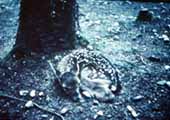 The majority of Fallow
fawns are born between May and early June, weighing approximately
4.5 kg. At birth they can be as varied in colour as the adults
but all will be spotted to a greater or lesser degree. The adult
male or buck stands about 90-95 cm at the shoulder and can weigh
upward of 70 kg, depending upon the time of the year and condition.
Does are slightly smaller than the buck, standing 80-85 cm at
the shoulder and weighing about 45 kg. Slightly larger than a
domestic goat, the Welsh name for Fallow is ‘gafrdanas’ which
means Danish Goat.
The majority of Fallow
fawns are born between May and early June, weighing approximately
4.5 kg. At birth they can be as varied in colour as the adults
but all will be spotted to a greater or lesser degree. The adult
male or buck stands about 90-95 cm at the shoulder and can weigh
upward of 70 kg, depending upon the time of the year and condition.
Does are slightly smaller than the buck, standing 80-85 cm at
the shoulder and weighing about 45 kg. Slightly larger than a
domestic goat, the Welsh name for Fallow is ‘gafrdanas’ which
means Danish Goat.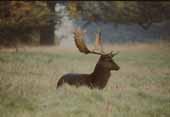 The Black Fallow of
Epping Forest are rumoured to have been introduced by James I
who brought them from Norway to Scotland and thence to Epping
Forest. The origins of New Forest Fallow are similar but the herds
are predominantly Common coloured. The predominance of any colour
variety is usually down to the management practices in that area
and if left, a herd will develop a mixture of all colour variations.
The spotted and graduated coat of the Fallow makes it a master
of camouflage and gives them the ability to just disappear in
woodland. Fallow will often stand quite motionless and are not
seen until they are practically stood on or the movement of a
flicking ear gives away their presence. In the open however the
large number of eyes and ears in a group makes then a difficult
animal to approach.
The Black Fallow of
Epping Forest are rumoured to have been introduced by James I
who brought them from Norway to Scotland and thence to Epping
Forest. The origins of New Forest Fallow are similar but the herds
are predominantly Common coloured. The predominance of any colour
variety is usually down to the management practices in that area
and if left, a herd will develop a mixture of all colour variations.
The spotted and graduated coat of the Fallow makes it a master
of camouflage and gives them the ability to just disappear in
woodland. Fallow will often stand quite motionless and are not
seen until they are practically stood on or the movement of a
flicking ear gives away their presence. In the open however the
large number of eyes and ears in a group makes then a difficult
animal to approach.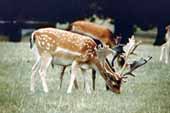 Plants which have
been found not to be eaten by Fallow include ragwort, foxglove
and stinging nettle. In areas where these deer are abundant it
is not unusual to see a well defined browse line on trees and
shrubs between 1.5 and 2m above the ground. It can be more than
this as Fallow will stand on their back legs to reach food or
browse higher up when conditions are hard. Where rubbish bins
are found Fallow have been known to eat from these and items such
as balloons, silver paper, elastic bands and sweet wrappers have
all been found in the stomachs of Fallow deer. Like most deer
Fallow seem to acquire their water requirements mostly from what
they eat or from dew and are rarely seen drinking. When undisturbed
Fallow can be seen feeding at all times of the day, however the
main feeding activity takes place around dawn and the late afternoon
or evening. Between these times the Fallow lie up in some undisturbed
place to ruminate and chew the cud. During the rut large bucks
may stop feeding completely and a loss of condition will often
result. Younger bucks hanging around on the fringes will continue
to eat as normal. When disturbed whilst out feeding, animals will
follow the dominant doe of the group back into cover, all moving
off in a distinct pecking order of dominance. Any mature bucks
in the group will generally move off in a different direction
and not follow the doe. Before moving out into an open area to
feed, small groups will form up just behind the edge of a wood
and move about, wearing away quite a noticeable path before venturing
out once they are assured that it is safe to do so.
Plants which have
been found not to be eaten by Fallow include ragwort, foxglove
and stinging nettle. In areas where these deer are abundant it
is not unusual to see a well defined browse line on trees and
shrubs between 1.5 and 2m above the ground. It can be more than
this as Fallow will stand on their back legs to reach food or
browse higher up when conditions are hard. Where rubbish bins
are found Fallow have been known to eat from these and items such
as balloons, silver paper, elastic bands and sweet wrappers have
all been found in the stomachs of Fallow deer. Like most deer
Fallow seem to acquire their water requirements mostly from what
they eat or from dew and are rarely seen drinking. When undisturbed
Fallow can be seen feeding at all times of the day, however the
main feeding activity takes place around dawn and the late afternoon
or evening. Between these times the Fallow lie up in some undisturbed
place to ruminate and chew the cud. During the rut large bucks
may stop feeding completely and a loss of condition will often
result. Younger bucks hanging around on the fringes will continue
to eat as normal. When disturbed whilst out feeding, animals will
follow the dominant doe of the group back into cover, all moving
off in a distinct pecking order of dominance. Any mature bucks
in the group will generally move off in a different direction
and not follow the doe. Before moving out into an open area to
feed, small groups will form up just behind the edge of a wood
and move about, wearing away quite a noticeable path before venturing
out once they are assured that it is safe to do so.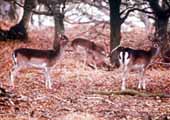 Fallow are similar to
Red and Sika in that they are a herding species. However, the
composition of the herd varies according to the time of the year.
For most of the year there will be two distinct groups; one of
adult females with yearlings and fawns, the other of bucks living
away from the does. The groups then rejoin for the rut. It is
only during the rut that fallow display any territorial behaviour.
The bucks set up their traditional rutting stands, often returning
to the same place year after year. Fallow do not establish a territory
but will inhabit a ‘home range’ over which they will travel, often
covering quite large distances. Within the home range will be
areas that are more frequented than others.
Fallow are similar to
Red and Sika in that they are a herding species. However, the
composition of the herd varies according to the time of the year.
For most of the year there will be two distinct groups; one of
adult females with yearlings and fawns, the other of bucks living
away from the does. The groups then rejoin for the rut. It is
only during the rut that fallow display any territorial behaviour.
The bucks set up their traditional rutting stands, often returning
to the same place year after year. Fallow do not establish a territory
but will inhabit a ‘home range’ over which they will travel, often
covering quite large distances. Within the home range will be
areas that are more frequented than others.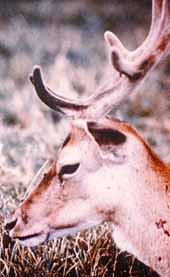 The rut starts in
late August or early September, reaching a peak in October and
is indicated by a change in the behaviour of the bucks, the thickening
of their necks and the setting up of rutting stands. These stands
consist of scrapes in the ground and thrashed bushes and trees.
The area that they will be spread over is dependant upon the local
Fallow population density, with those areas of lower densities
sustaining larger territories. The buck urinates into the scrapes
and may also urinate upon himself or his antlers. During the rut
bucks develop a very strong odour which is easily detectable even
by humans. Unlike Sika or Red deer, Fallow do not appear to use
the scrapes as wallows. The bucks will also thrash and fray bushes
and trees, depositing scent from their sub-orbital scent glands
onto the trunks of trees. When on the rutting stand the buck emits
a characteristic groaning call which is similar to a deep extended
belch. The does congregate around the rutting stand attracted
by the activities of the buck and the audible and oflactory stimuli.
The buck then moves around the assembled does testing them for
sexual receptiveness by sniffing around the anal area of the does
and tasting their urine to ascertain which ones are in oestrus.
This sampling of the does is known as ‘Flehmen’ and is indicated
by a buck rolling back his lips and raising his head. If the doe
is in oestrus the buck may then chase her, sometimes a considerable
distance from the rutting stand, before mating takes place. During
the rut bucks will fight with each other, the fight consisting
mainly of shoving competitions with antlers locked. As the bucks
push they twist with their necks to try and force their opponent
backwards. When the weaker animal eventually gives in, the winner
will often gash the flank of the loser with its brow tines as
it turns to flee. Yearlings and other young bucks will generally
be tolerated by a buck on a rutting stand, but if an animal of
equal size appears then a fight will usually occur.
The rut starts in
late August or early September, reaching a peak in October and
is indicated by a change in the behaviour of the bucks, the thickening
of their necks and the setting up of rutting stands. These stands
consist of scrapes in the ground and thrashed bushes and trees.
The area that they will be spread over is dependant upon the local
Fallow population density, with those areas of lower densities
sustaining larger territories. The buck urinates into the scrapes
and may also urinate upon himself or his antlers. During the rut
bucks develop a very strong odour which is easily detectable even
by humans. Unlike Sika or Red deer, Fallow do not appear to use
the scrapes as wallows. The bucks will also thrash and fray bushes
and trees, depositing scent from their sub-orbital scent glands
onto the trunks of trees. When on the rutting stand the buck emits
a characteristic groaning call which is similar to a deep extended
belch. The does congregate around the rutting stand attracted
by the activities of the buck and the audible and oflactory stimuli.
The buck then moves around the assembled does testing them for
sexual receptiveness by sniffing around the anal area of the does
and tasting their urine to ascertain which ones are in oestrus.
This sampling of the does is known as ‘Flehmen’ and is indicated
by a buck rolling back his lips and raising his head. If the doe
is in oestrus the buck may then chase her, sometimes a considerable
distance from the rutting stand, before mating takes place. During
the rut bucks will fight with each other, the fight consisting
mainly of shoving competitions with antlers locked. As the bucks
push they twist with their necks to try and force their opponent
backwards. When the weaker animal eventually gives in, the winner
will often gash the flank of the loser with its brow tines as
it turns to flee. Yearlings and other young bucks will generally
be tolerated by a buck on a rutting stand, but if an animal of
equal size appears then a fight will usually occur.